Abstract
OBJECTIVE: Survivors and nonsurvivors among 103 consecutive pediatric patients with massive burns were compared in an effort to define the predictors of mortality in massively burned children. SUMMARY BACKGROUND DATA: Predictors of mortality in burns that are used commonly are age, burn size, and inhalation injury. In the past, burns over 80% of the body surface area that are mostly full-thickness often were considered fatal, especially in children and in the elderly. In the past 15 years, advances in burn treatment have increased rates of survival in those patients treated at specialized burn centers. The purpose of this study was to document the extent of improvement and to define the current predictors of mortality to further focus burn care. METHODS: Beginning in 1982, 103 children ages 6 months to 17 years with burns covering at least 80% of the body surface (70% full-thickness), were treated in the authors' institution by early excision and grafting and have been observed to determine outcome. The authors divided collected independent variables from the time of injury into temporally related groups and analyzed the data sequentially and cumulatively through univariate statistics and through pooled, cross-sectional multivariate logistic regression to determine which variables predict the probability of mortality. RESULTS: The mortality rate for this series of massively burned children was 33%. Lower age, larger burn size, presence of inhalation injury, delayed intravenous access, lower admission hematocrit, lower base deficit on admission, higher serum osmolarity at arrival to the authors' hospital, sepsis, inotropic support requirement, platelet count < 20,000, and ventilator dependency during the hospital course significantly predict increased mortality. CONCLUSIONS: The authors conclude that mortality has decreased in massively burned children to the extent that nearly all patients should be considered as candidates for survival, regardless of age, burn size, presence of inhalation injury, delay in resuscitation, or laboratory values on initial presentation. During the course of hospitalization, the development of sepsis and multiorgan failure is a harbinger of poor outcome, but the authors have encountered futile cases only rarely. The authors found that those patients who are most apt to die are the very young, those with limited donor sites, those who have inhalation injury, those with delays in resuscitation, and those with burn-associated sepsis or multiorgan failure.
Full text
PDF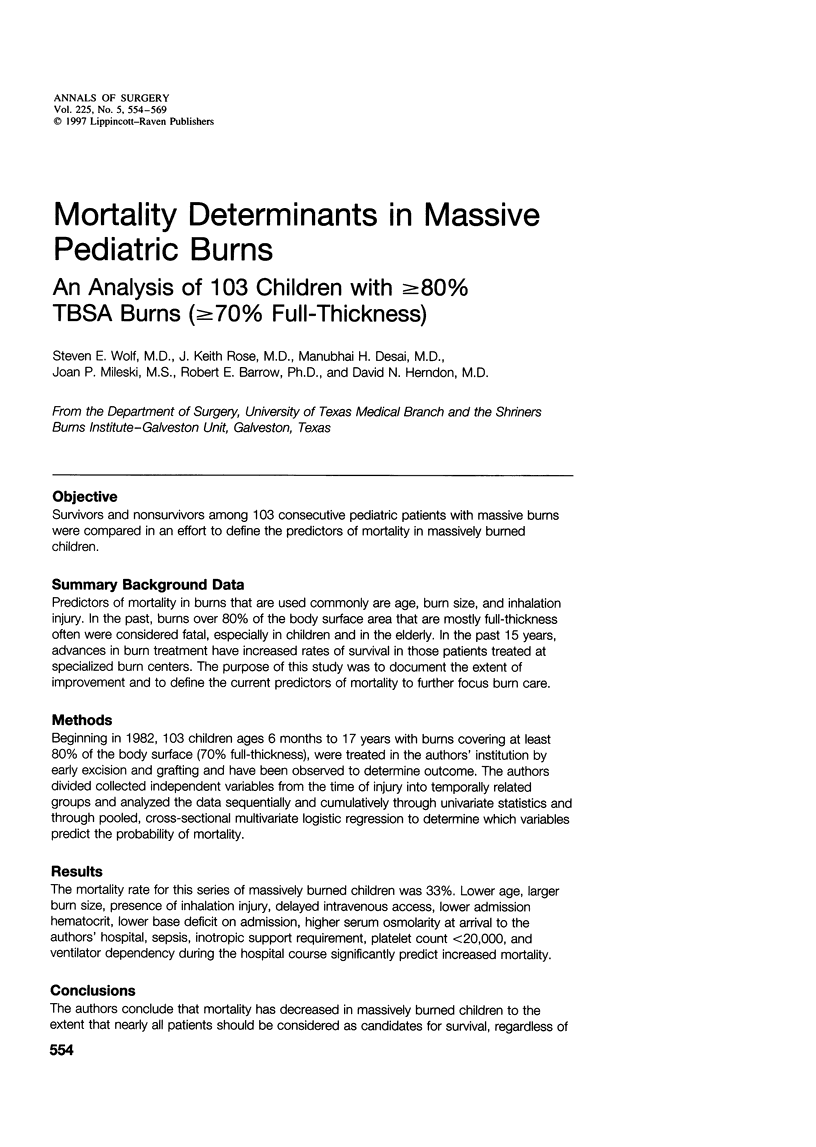
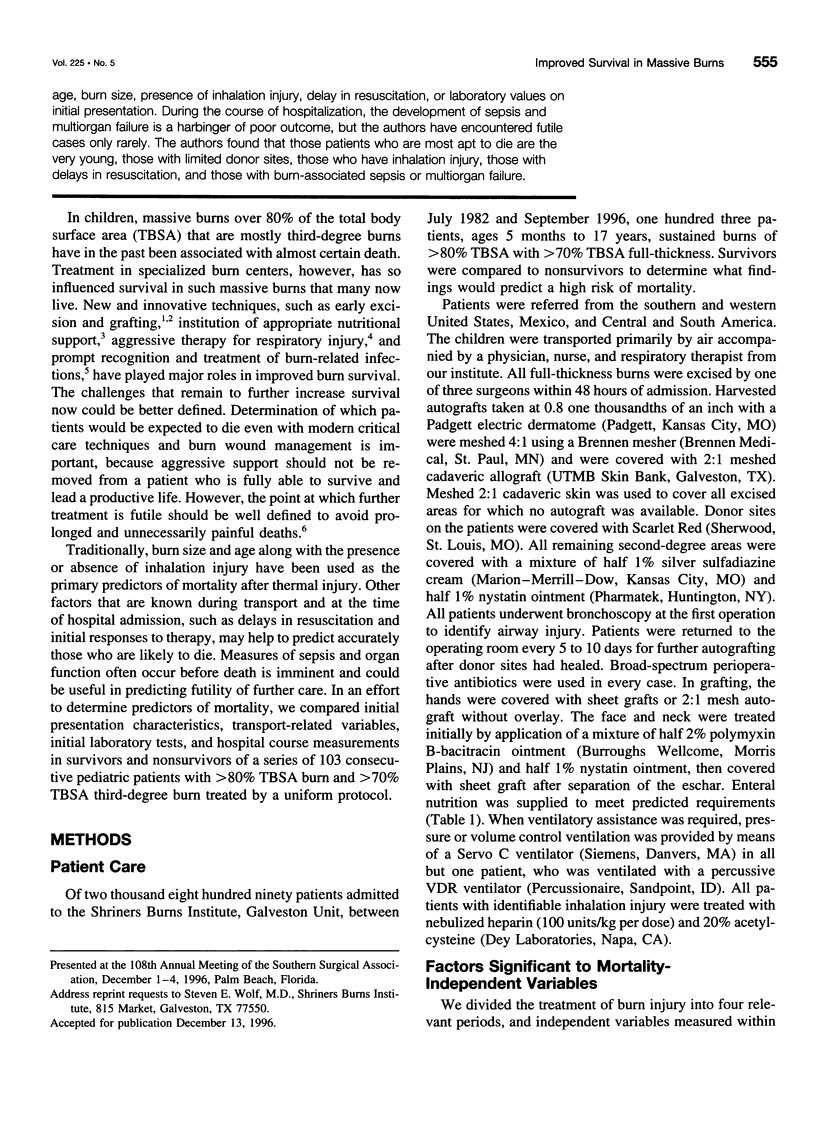
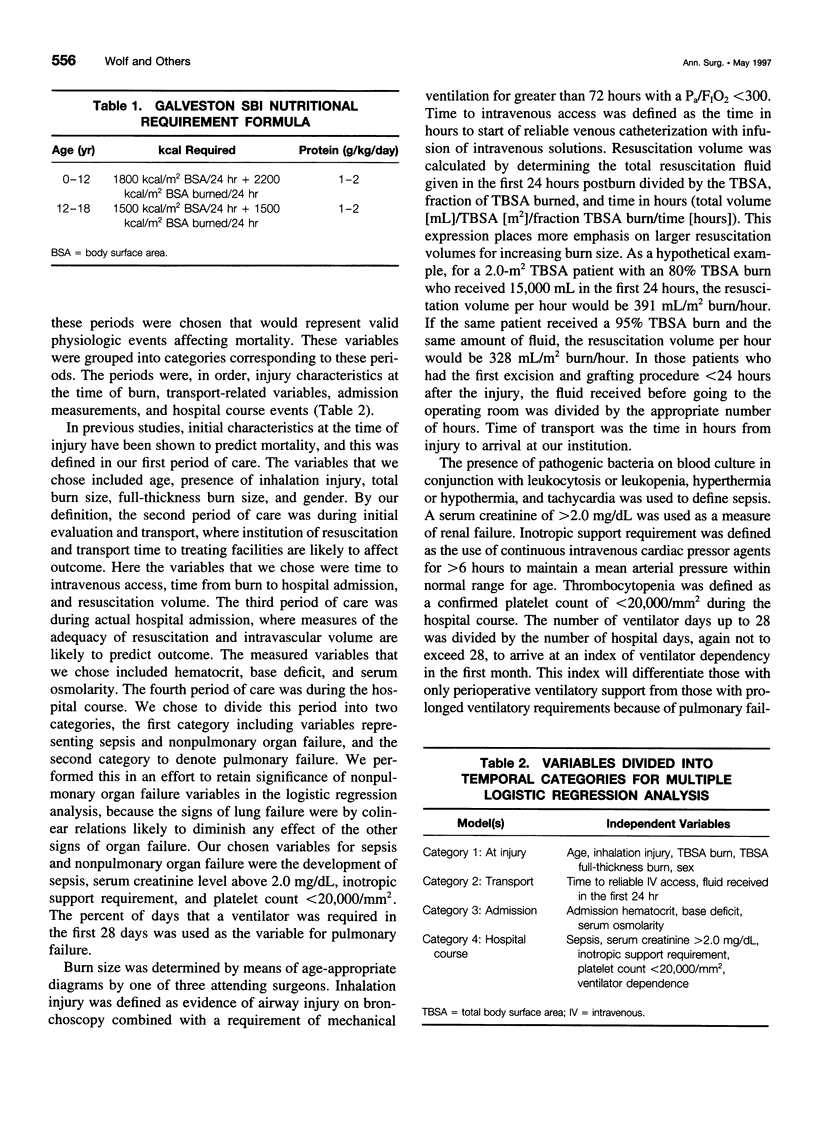
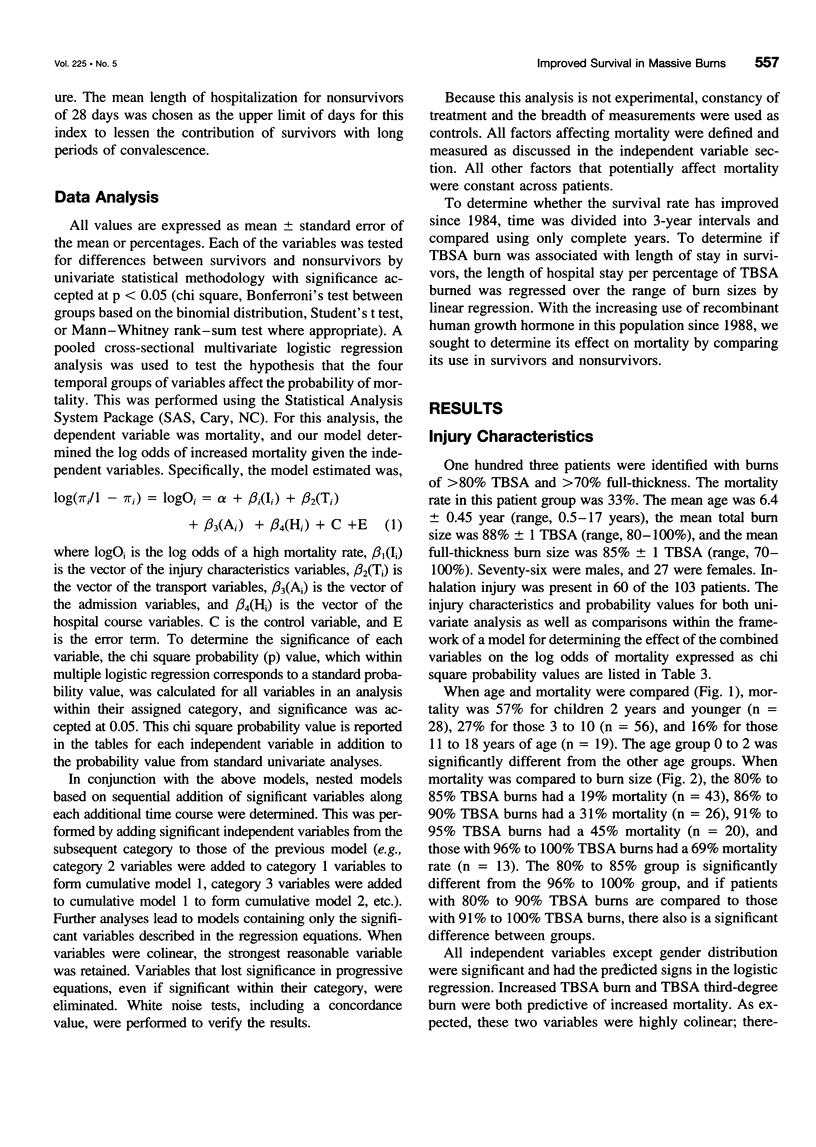
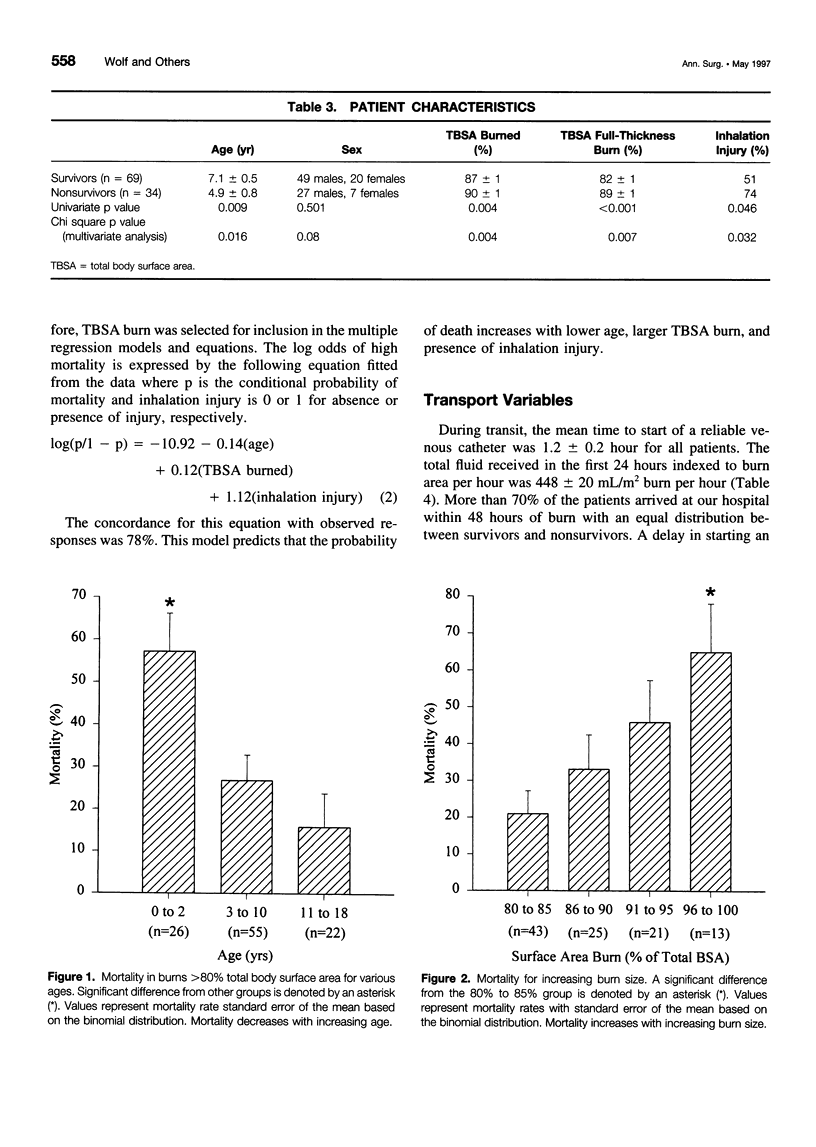
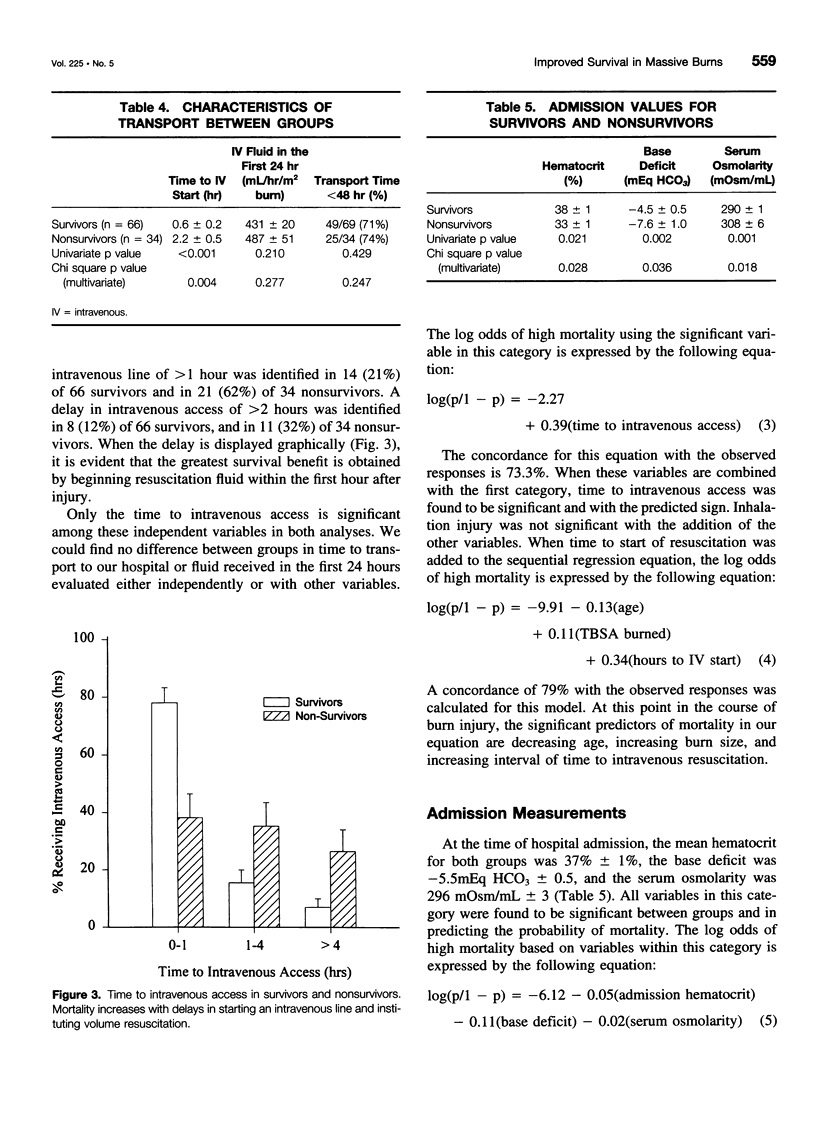
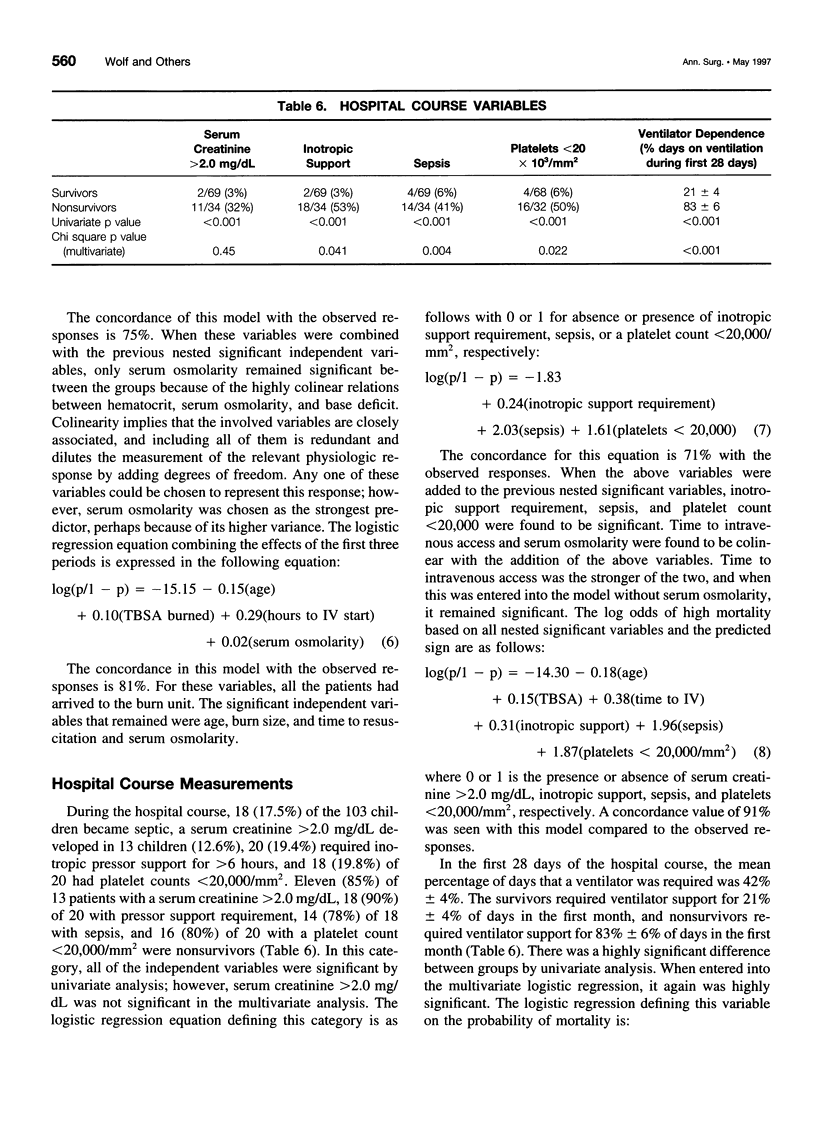
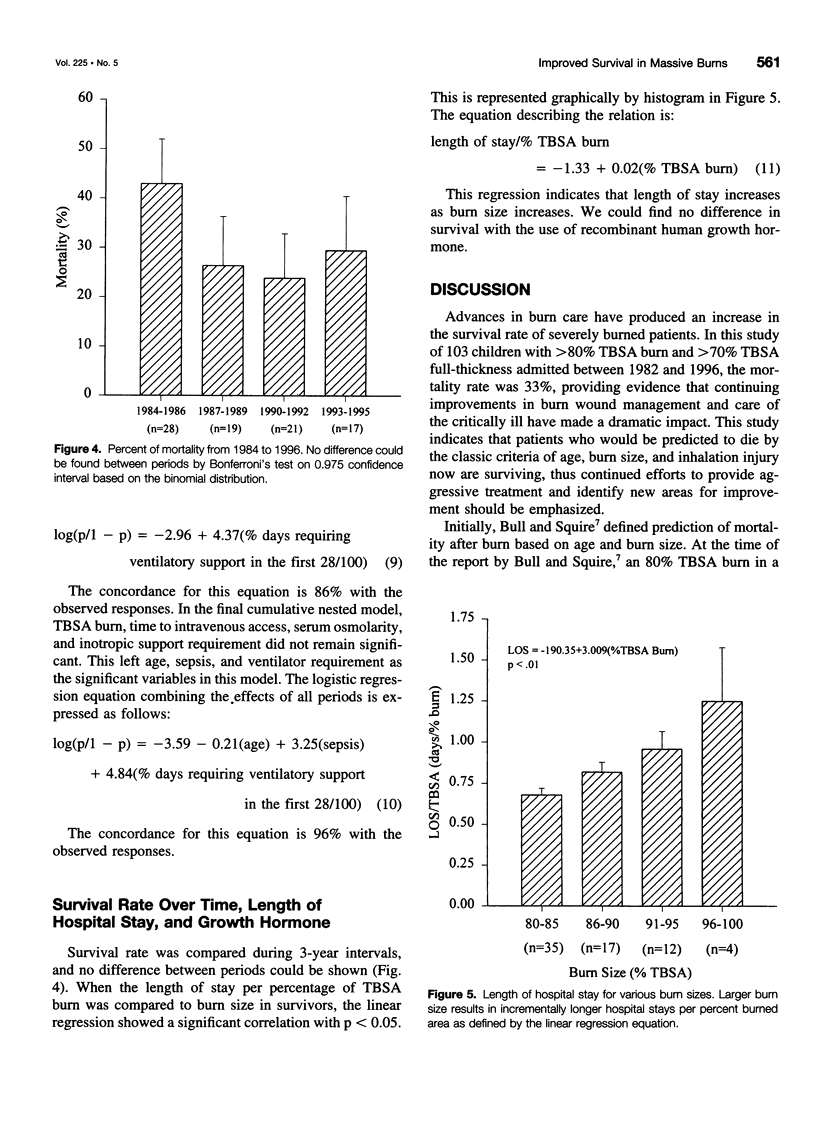
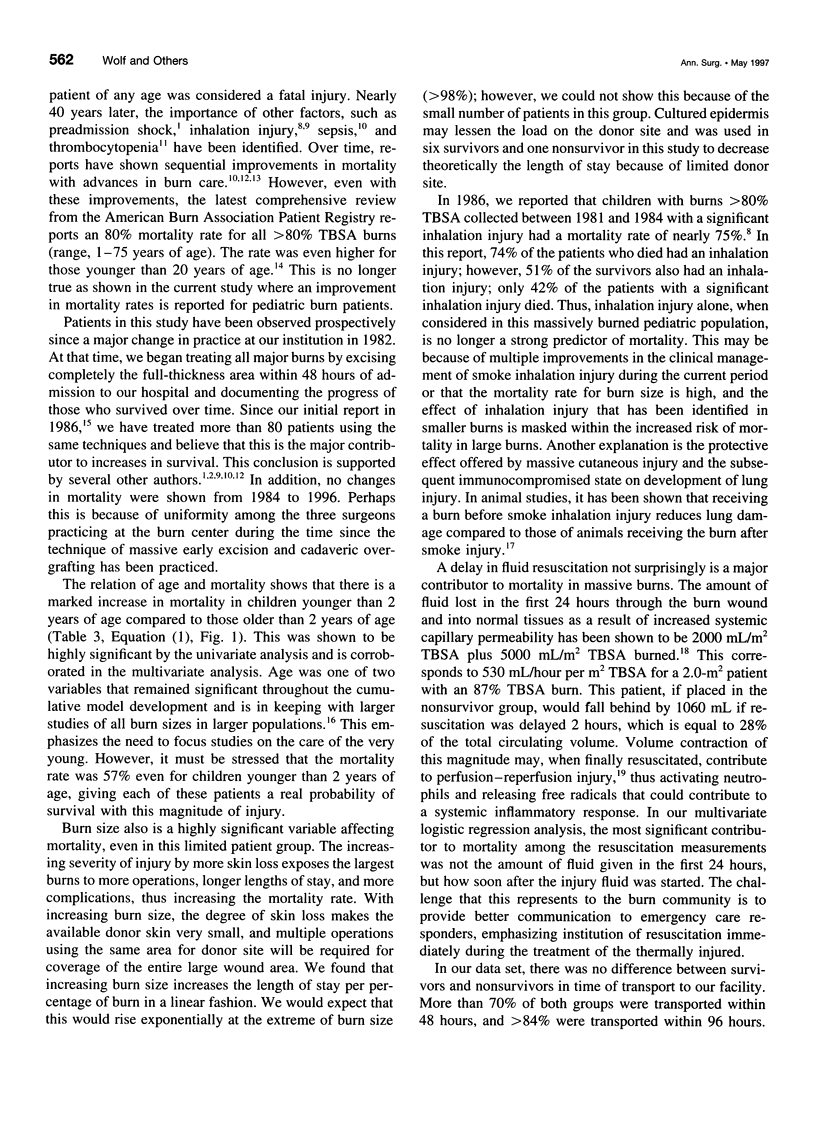
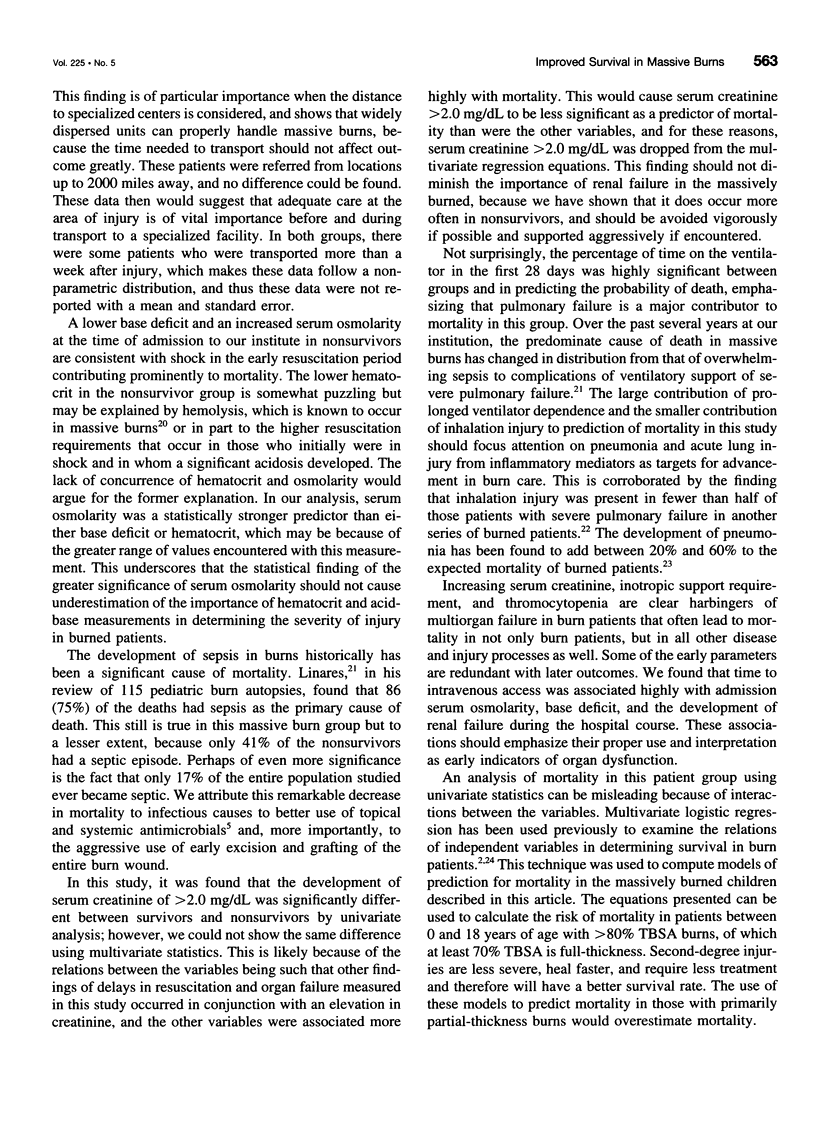
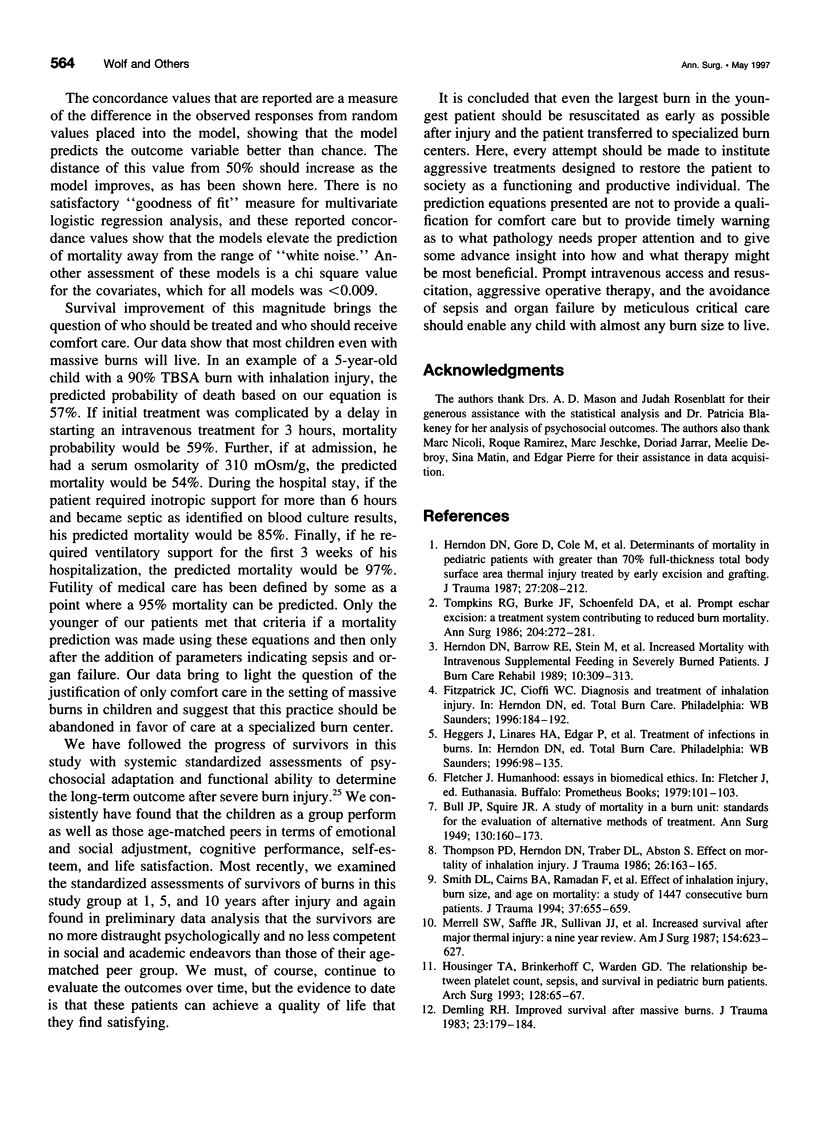
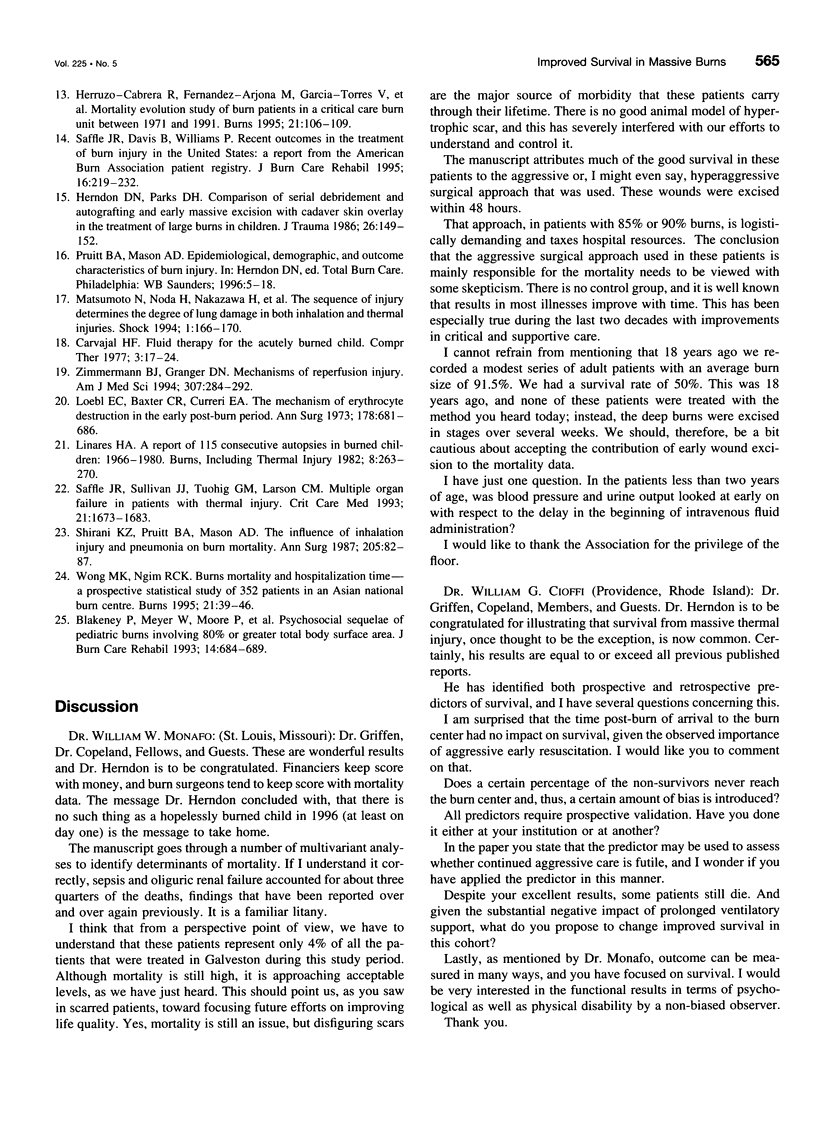
Selected References
These references are in PubMed. This may not be the complete list of references from this article.
- Blakeney P., Meyer W., Moore P., Murphy L., Broemeling L., Robson M., Herndon D. Psychosocial sequelae of pediatric burns involving 80% or greater total body surface area. J Burn Care Rehabil. 1993 Nov-Dec;14(6):684–689. doi: 10.1097/00004630-199311000-00015. [DOI] [PubMed] [Google Scholar]
- Bull J. P., Squire J. R. A Study of Mortality in a Burns Unit: Standards for the Evaluation of Alternative Methods of Treatment. Ann Surg. 1949 Aug;130(2):160–173. doi: 10.1097/00000658-194908000-00002. [DOI] [PMC free article] [PubMed] [Google Scholar]
- Carvajal H. F. Fluid therapy for the acutely burned child. Compr Ther. 1977 Mar;3(3):17–24. [PubMed] [Google Scholar]
- Demling R. H. Improved survival after massive burns. J Trauma. 1983 Mar;23(3):179–184. doi: 10.1097/00005373-198303000-00002. [DOI] [PubMed] [Google Scholar]
- Herndon D. N., Barrow R. E., Stein M., Linares H., Rutan T. C., Rutan R., Abston S. Increased mortality with intravenous supplemental feeding in severely burned patients. J Burn Care Rehabil. 1989 Jul-Aug;10(4):309–313. doi: 10.1097/00004630-198907000-00004. [DOI] [PubMed] [Google Scholar]
- Herndon D. N., Gore D., Cole M., Desai M. H., Linares H., Abston S., Rutan T., Van Osten T., Barrow R. E. Determinants of mortality in pediatric patients with greater than 70% full-thickness total body surface area thermal injury treated by early total excision and grafting. J Trauma. 1987 Feb;27(2):208–212. doi: 10.1097/00005373-198702000-00020. [DOI] [PubMed] [Google Scholar]
- Herndon D. N., Parks D. H. Comparison of serial debridement and autografting and early massive excision with cadaver skin overlay in the treatment of large burns in children. J Trauma. 1986 Feb;26(2):149–152. doi: 10.1097/00005373-198602000-00009. [DOI] [PubMed] [Google Scholar]
- Herruzo-Cabrera R., Fernandez-Arjona M., Garcia-Torres V., Martinez-Ratero S., Lenguas-Portero F., Rey-Calero J. Mortality evolution study of burn patients in a critical care burn unit between 1971 and 1991. Burns. 1995 Mar;21(2):106–109. doi: 10.1016/0305-4179(95)92134-x. [DOI] [PubMed] [Google Scholar]
- Housinger T. A., Brinkerhoff C., Warden G. D. The relationship between platelet count, sepsis, and survival in pediatric burn patients. Arch Surg. 1993 Jan;128(1):65–67. doi: 10.1001/archsurg.1993.01420130073011. [DOI] [PubMed] [Google Scholar]
- Linares H. A. A report of 115 consecutive autopsies in burned children: 1966-80. Burns Incl Therm Inj. 1982 Mar;8(4):263–270. doi: 10.1016/0305-4179(82)90007-9. [DOI] [PubMed] [Google Scholar]
- Loebl E. C., Baxter C. R., Curreri P. W. The mechanism of erythrocyte destruction in the early post-burn period. Ann Surg. 1973 Dec;178(6):681–686. doi: 10.1097/00000658-197312000-00001. [DOI] [PMC free article] [PubMed] [Google Scholar]
- Matsumoto N., Noda H., Nakazawa H., Traber L. D., Herndon D. N., Traber D. L. The sequence of injury determines the degree of lung damage in both inhalation and thermal injuries. Shock. 1994 Mar;1(3):166–170. doi: 10.1097/00024382-199403000-00002. [DOI] [PubMed] [Google Scholar]
- Merrell S. W., Saffle J. R., Sullivan J. J., Larsen C. M., Warden G. D. Increased survival after major thermal injury. A nine year review. Am J Surg. 1987 Dec;154(6):623–627. doi: 10.1016/0002-9610(87)90229-7. [DOI] [PubMed] [Google Scholar]
- Saffle J. R., Davis B., Williams P. Recent outcomes in the treatment of burn injury in the United States: a report from the American Burn Association Patient Registry. J Burn Care Rehabil. 1995 May-Jun;16(3 Pt 1):219–289. doi: 10.1097/00004630-199505000-00002. [DOI] [PubMed] [Google Scholar]
- Saffle J. R., Sullivan J. J., Tuohig G. M., Larson C. M. Multiple organ failure in patients with thermal injury. Crit Care Med. 1993 Nov;21(11):1673–1683. doi: 10.1097/00003246-199311000-00016. [DOI] [PubMed] [Google Scholar]
- Shirani K. Z., Pruitt B. A., Jr, Mason A. D., Jr The influence of inhalation injury and pneumonia on burn mortality. Ann Surg. 1987 Jan;205(1):82–87. doi: 10.1097/00000658-198701000-00015. [DOI] [PMC free article] [PubMed] [Google Scholar]
- Smith D. L., Cairns B. A., Ramadan F., Dalston J. S., Fakhry S. M., Rutledge R., Meyer A. A., Peterson H. D. Effect of inhalation injury, burn size, and age on mortality: a study of 1447 consecutive burn patients. J Trauma. 1994 Oct;37(4):655–659. doi: 10.1097/00005373-199410000-00021. [DOI] [PubMed] [Google Scholar]
- Thompson P. B., Herndon D. N., Traber D. L., Abston S. Effect on mortality of inhalation injury. J Trauma. 1986 Feb;26(2):163–165. doi: 10.1097/00005373-198602000-00012. [DOI] [PubMed] [Google Scholar]
- Tompkins R. G., Burke J. F., Schoenfeld D. A., Bondoc C. C., Quinby W. C., Jr, Behringer G. C., Ackroyd F. W. Prompt eschar excision: a treatment system contributing to reduced burn mortality. A statistical evaluation of burn care at the Massachusetts General Hospital (1974-1984). Ann Surg. 1986 Sep;204(3):272–281. doi: 10.1097/00000658-198609000-00006. [DOI] [PMC free article] [PubMed] [Google Scholar]
- Wong M. K., Ngim R. C. Burns mortality and hospitalization time--a prospective statistical study of 352 patients in an Asian National Burn Centre. Burns. 1995 Feb;21(1):39–46. doi: 10.1016/0305-4179(95)90780-4. [DOI] [PubMed] [Google Scholar]
- Zimmerman B. J., Granger D. N. Mechanisms of reperfusion injury. Am J Med Sci. 1994 Apr;307(4):284–292. doi: 10.1097/00000441-199404000-00009. [DOI] [PubMed] [Google Scholar]


